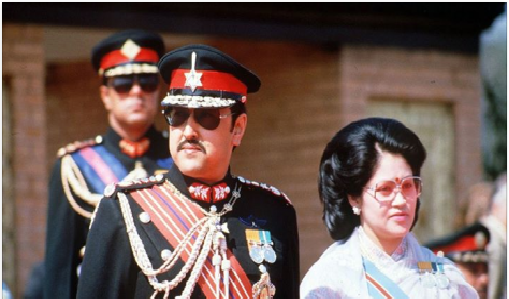
 |
Coming to the throne of Nepal at the age of 27 King Birendra (born 1945) sought to emphasize economic development and a decentralization of authority. King Birendra (Bir Bikram Shah Dev) of Nepal was born on December 28, 1945, the eldes
t son of King Mahendra and Queen Indra. He had two brothers and three sisters, as well as numerous aunts, uncles, and cousins in the royal family entourage in and around the palace in Nepal's capital city. Birendra married Aishwarya R.L. Rana on February 23, 1970; they had three children— Crown Prince Dipindra, Prince Nirajan, and Princess Shruti. Birendra was born while the Rana familystill dominated the government of Nepal and the royal family was kept under strict surveillence. But the political movement that overthrew the Ranas occurred when the crown prince was only five years old, and his socialization into politics and society in Nepal and abroad was very different from that of
his father,King Mahendra. Birendra's formal education, for instance, was in prestigious schools outside Nepal: St. Joseph's in Darjeeling, India; Eton in England; Harvard University; and the University of Tokyo. In the process, he was exposed to a rich assortment of theories and models on political and economic change in "developing" societies like Nepal, and he demonstrated an open and inquisitive mind on such subjects. King Birendra came to the throne on January 31, 1972, the tenth ruler in the Shah dynasty in Nepal. He quickly demonstrated a different approach to the processes of governance than those adopted by his predecessor, and important changes in both the style and substance of policies were introduced. The preoccupation of King Mahendra with the minutia of political developments anywhere in Nepal was replaced by a new strategy that, in effect, downgraded politics and focussed instead on economic development themes and issues. The objective was to insulate economic programs from the narrow political and interest group concerns that had, supposedly, hampered their implementation under his father. As a necessary accompaniment to this new approach, changes in the entourage of advisors around the king were required. The groups of experienced and politically astute bureaucrats that King Mahendra had used were quickly replaced by younger, well-educated "modernistic" technicians who presum
t son of King Mahendra and Queen Indra. He had two brothers and three sisters, as well as numerous aunts, uncles, and cousins in the royal family entourage in and around the palace in Nepal's capital city. Birendra married Aishwarya R.L. Rana on February 23, 1970; they had three children— Crown Prince Dipindra, Prince Nirajan, and Princess Shruti. Birendra was born while the Rana familystill dominated the government of Nepal and the royal family was kept under strict surveillence. But the political movement that overthrew the Ranas occurred when the crown prince was only five years old, and his socialization into politics and society in Nepal and abroad was very different from that of
his father,King Mahendra. Birendra's formal education, for instance, was in prestigious schools outside Nepal: St. Joseph's in Darjeeling, India; Eton in England; Harvard University; and the University of Tokyo. In the process, he was exposed to a rich assortment of theories and models on political and economic change in "developing" societies like Nepal, and he demonstrated an open and inquisitive mind on such subjects. King Birendra came to the throne on January 31, 1972, the tenth ruler in the Shah dynasty in Nepal. He quickly demonstrated a different approach to the processes of governance than those adopted by his predecessor, and important changes in both the style and substance of policies were introduced. The preoccupation of King Mahendra with the minutia of political developments anywhere in Nepal was replaced by a new strategy that, in effect, downgraded politics and focussed instead on economic development themes and issues. The objective was to insulate economic programs from the narrow political and interest group concerns that had, supposedly, hampered their implementation under his father. As a necessary accompaniment to this new approach, changes in the entourage of advisors around the king were required. The groups of experienced and politically astute bureaucrats that King Mahendra had used were quickly replaced by younger, well-educated "modernistic" technicians who presum

 |









0 comments: